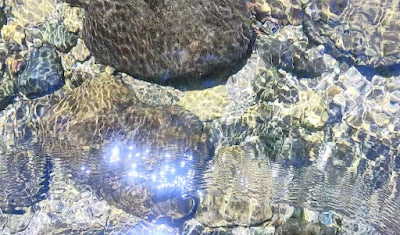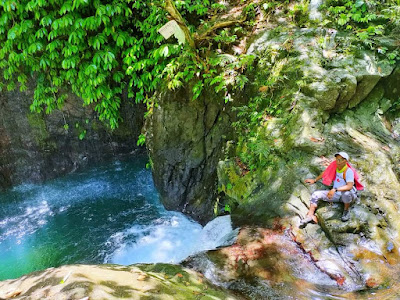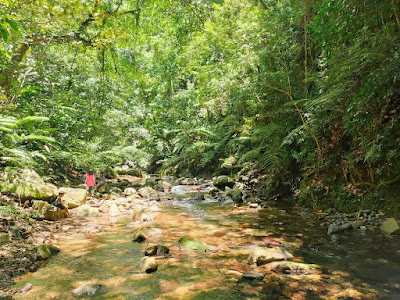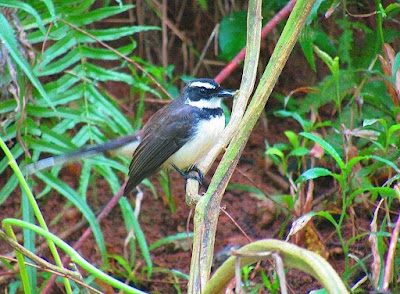📌 Likid Falls, Sicul, Santa Praxedes, Cagayan
https://youtu.be/Hxy9hW3Ckps
PROLOGUE:" So lovely, must have been gazed upon by angels in heaven on their flight".
 |
| The upper part of Likid Falls |
As I took a deep breath with the fern-scented saturated air of the wild tropical rainforest, I sighted a couple of bird pecking through a barely ripened water fig (tebbeg) donned with tangling vines and other epiphytes (lanut). So flamboyant as they were that I was startled by their sheer beauty, captivated by their colorful beaks and plumage, illuminated by the morning sun's rays that added drama to the spectacular view.
 |
| The dense jungles of Santa Praxedes town |
Before my sanity has backed into normal and hurriedly prompted me to peek into my camera lens, the birds panicked as they were distracted by the sound of splashing waters created as I waded against the stream's rapid current . They frantically flew out of sight, engulfed by the unending vastness of the impenetrable thickets and tangled mass of the tropical vegetation of the Cordilleras.
Exactly, that I was in the geographical north of the formidable Cordillera mountian range extending from Bangui and Pagudpud, Ilocos Norte eastward to Sta. Praxedes and Claveria, Cagayan.
Few know that some parts of Cagayan touch the hemlines of the Cordilleras.
 |
| Sta. Praxedes, the geographic north of the Cordilleras |
At the point where this tiny speck of serenity confined deep within the jungle to where I wandered was in Sicul, Santa Praxedes in Cagayan, the province where adventures appear to never end.
And if you have not looked at Cagayan, particularly in the seemingly sleepy and not-so-bustling town of Santa Praxedes lately, then look again...
Santa Praxedes is an extreme northern Luzon anomaly of nature, a relatively peaceful, sparsely populated municipality located northwest of Cagayan province. Golden sand and white pebble beaches tucked within tranquil coves give way to a rugged forested interior; some more than half of the land area is still covered in forests, with its parts which are among the richest and most diverse on Earth.
 |
| Just one of the several tropical beach coves of Sta. Praxedes |
In fact, the scientific journal "Frontiers of Biogeography" concluded that the island of Luzon is the most biodiverse on the planet.
The rainforest of Santa Praxedes is virtually part of the massive and life-teeming Kalbario-Patapat Protected Area Natural Park, a key biodiversity (KBA) and an important bird area (IBA) declared by the DENR under the NIPAS or the New Integrated Protected Areas Systems.
Much of the protected area however are located primarily in the towns of Adams and Pagudpud, Ilocos Norte with buffer zones designated in Sta Praxedes and Claveria southern grids both in Cagayan.
 |
| The emerald basin of the Likid Falls |
The sheer totality of the natural assets within these zones including known species of high concern (Luzon endemic frog, horseshoe bat, flame breasted fruit dove, whiskered pita, green faced parrot finch etc.) as well as animal and plant forms yet to be discovered, is incalculably large. This KBA is home to more than a dozen of different fern species endemic to the country, not found anywhere else.
On that fine July morning, our team paid a courtesy visit to the town hall of the municipality of Sta. Praxedes prior to our excursion to enchantment.
 |
| The municipality's center of governance |
Our destination was mapped to Likid Falls in the far flung village of Sicul, about 8 kilometers from the town hall. The road is less traveled. Dusty, narrow, bumpy and hot as we hiked through screes on dried stream beds, devoid of tall vegetation.
Still far from the shady forest floor, nearby we cut a broad palm leaf called "labig" and transformed it into a sun shade covering our delicate heads.
Our approach to a small stream now signified our coveted adventure under the enormous tropical rainforest. Sicul is rich in Earth's rarest commodity; even rarer than diamonds- tropical forests little touched by humans.
 |
| Upstream along the way going to Likid Falls |
Clicking for a series of striking photos of the understory and canopy, I shot an indescribable extraordinary biological richness residing in the trackless rainforests, the remote mountains and the glass-clear stream waters.
I was blown away with the sounds of nature along the river lined with supermassive tree trunks and scrubs dominated by creeping vines; the caw of a kingfisher (salaksak) scanning the stream for food, the song of a sunbird (sawsaw-it) perching on a raintree (akasia) branch, the gushing murmur of the river flow or the sleep-inducing chit chats of the cicadas (kuliglig).
 |
| Glass-clear stream waters rich in prawns |
It was already noon. Broad daylight. We were still far to our destination- the brilliant and splashy Likid Falls waiting for us. Our excitement has been halted by thirst and so together with our team, we laid for a couple of minutes for a gasp of air and a sip of water. Not so far, we noticed a lonesome hive, probably that of a bumble bee or a yellow jacket wasp. It was so fascinating; the insect gathering debris and constructing its abode.
 |
| Indescribable serenity |
Through the silence that brought my heartbeats to the ears, I was beginning to hear the faraway rhythm of rapids or swooshing waters, like a sound that drifts into a dream. Strenghtened by the air of the surrounding verdant greeneries, we continued to thread the river, heading to our aimed target. The shallows are rich in thumb-sized forest river prawns and fishes.
The landscapes, at any angle were so breath-taking you will be forgiven for thinking you are really existing in the land that has been created before time.
 |
| So lovely, must have been gazed by angels in heaven on their flight |
After an enduring, not so walk-in-the park journey, we have reached our bingo- the serene and lovely first tier of Likid Falls, all for the first time except for our kid local guides who, accordingly have been here for the third time around.
 |
| The first and lower tier of Likid Falls |
| I was astonished with how the water plummets, up from 10 feet high cliff into a bluish-green gaping hole below with the same depth creating a deafening sound of gush that is pleasant to the ears. The depression is also fed by constantly raining waters that ooze from the rocky wall that surrounds it about 50 feet high. |
Jumping below from that pinnacle is so euphoric and adrenaline-rushing only the intrepid might dare to try.
 |
| Cliff-jumping in Likid Falls |
Truly, scenes so lovely, must have been gazed upon by angels in heaven on their flight.
It was like a fairy tale came true; that of a heaven placed on earth.
The falls embraces a wealth of pristine waters and its vicinity harbors wildlife lurking inconspicuously up and below.
 |
| A small speck of tranquility in the heart of the tropical rainforest |
So clean and clear directly seeping out from a crevice, we tapped our tumblers into the sprouting water and wetted our parched throats.
Not far from the first tier, we crossed through a more-than-human deep karst water to reach the colossal rock where the second tier of the Likid Falls is hidden.
 |
| The dangers of trekking the forest going to Likid Falls |
There on the top, the magnificence of Likid Falls mystified us once more right infront of our eyes; the others stunned and explicitly bewildered by the massive volume of water falling from a 20-foot high cliff side. As it plummeted to its deep aquamarine basin, mists blown by the wind drenched our faces into our eagerness for a quick dip.
 |
| Upper Likid Falls: mystifyingly beautiful |
Thriving undisturbed on the cliffs are taro-like plants called "bilagot", an edible local food.
Different ferns, bromeliads and water plants outlined the surrounding rocky area and all we could see to the horizon, in every direction, was unbroken canopy on its thousand shades of green and through it, a thin slash of the immaculate white river.
But Likid Falls beauty has faraway qualities that can change to a devastation on close scrutiny: The long grass blades and certain thorny vines will snag and prick, the slippery and sharp stones cut the unprotected feet, the emerald green but clear waters are deep and there maybe fangs, stingers and itchy hairs I hope I would never encounter.
 |
| Different ferns, bromeliads and water plants outlined the forest |
On our way back to reality, my brief detachment from the world to explore the paths less traveled brought peace and contentment in my heart. My intense desire to feed the urge of roaming the great outdoors has kept me alive and view the wild world through the lens of a deep, unwavering adventures into its most subtle, most appreciable form of beauty.
I still recall when I first felt the allure of Santa Praxedes through my getaways in one summer at Mingay beach, a tiny speck of tranquility tucked between mountains and the seas.
And I say it again.
If you have not looked at Cagayan particularly in Santa Praxedes lately, then look again. ™️
 |
| "Perhaps it was the adventure on the trail rather than the comfort in the final destination that still beckons us to roam into the great outdoors" |
https://m.facebook.com/story.php?story_fbid=pfbid0oaS4VG8S9cZ1DrALRoBP5JXmSZKqFtbxSg1sCSZbAwb88BCwgjePcaHxJ9M3MeMtl&id=100007283687906
Supplemental posts:
https://m.facebook.com/story.php?story_fbid=3152570194995739&id=100007283687906
https://m.facebook.com/story.php?story_fbid=3075876772665082&id=100007283687906
https://m.facebook.com/story.php?story_fbid=3034457923473634&id=100007283687906
#TheGreatOutdoors #IntoTheWildSeries #ExploreCagayan #BeyondLasam #TropicalRainforest





































